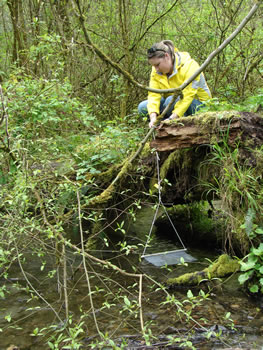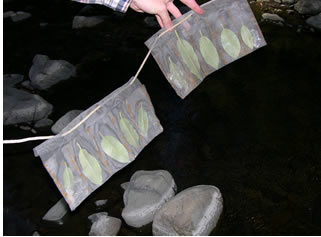Calendars 2011
gary.maguireCalendars
Schedule baiting times, lab work by emailing Marianne (melliott2@wsu.edu)
February 2011 – Schedule first baiting and volunteer training at the end of Feb/beginning of March
Schedule baiting times, lab work by emailing Marianne (melliott2@wsu.edu)
February 2011 – Schedule first baiting and volunteer training at the end of Feb/beginning of March
2010 pilot study results and planning for 2011 monitoring July 29, 2010.
The 2010 pilot study is completed. Thanks to all the volunteers and students who helped out!
Contact: Gary Chastagner, 253-445-4528 | WSU Puyallup Research & Extension Center, 2606 West Pioneer, Puyallup, WA, 98371-4998 USA Last updated January 2, 2013
The baiting for the 2010 pilot study is now complete. We are in the process of isolating and identifying all the Phytophthora species. Check out the results pages for the latest information.
Thanks to everyone for helping out with this project. We will be having a meeting/lunch event to look at our results and talk about next years monitoring towards the end of July. If you have ideas for other locations to monitor in 2011, let us know.
After two baiting intervals, we are happy to report that there has been no P. ramorum detected at any of the sites. Several different Phytophthora species have been isolated but not identified.
Thanks to the US Forest Service for providing two years worth of funding for this project!
Initial bait deployment and volunteer training is scheduled for four sites during the first week of March.
We will be holding a training session for people who wish to volunteer in the lab doing sample processing and Phytophthora identification sometime in mid-march. If you are interested in lab work, let Marianne know.
Marianne Elliott (melliott2@wsu.edu)
The 2011 monitoring is completed. Check out the results pages for the latest information. Thanks to all the students and volunteers who helped out. A number of interesting projects have been done by students in 2012 using isolates collected in the 2011 stream survey. We have also found some possible new species of Phytophthora, Pythium, and Halophytophthora. The 2011 survey provided some baseline information about the oomycete (aka ‘water molds’) flora of western Washington streams with a variety of land uses.
We’re gearing up to start the 2011 monitoring study. Check out the sites page to see where baiting is being planned. These are subject to change until the weeks of Feb 21-25 and Feb 28-Mar 4, when we set up the sites and deploy the first bait leaves. This year we will have some salt water sites in addition to freshwater streams, so we will learn more about Phytophthora and Pythium species found in those environments. Check this page to see dates and times for setting up your monitoring site.
Save the date – Thursday July 29 from 10 – 2 pm at WSU Puyallup. We will look at our results from this years monitoring and start planning next years. Lunch will be provided. RSVP Marianne Elliott (melliott2@wsu.edu)
Contact: Gary Chastagner, 253-445-4528 | WSU Puyallup Research & Extension Center, 2606 West Pioneer, Puyallup, WA, 98371-4998 USA
Last updated January 2, 2013
Contact: Gary Chastagner, 253-445-4528 | WSU Puyallup Research & Extension Center, 2606 West Pioneer, Puyallup, WA, 98371-4998 USA
Last updated January 2, 2013
In this project, we are involved with
|

2017-2018 Monitoring for Phytophthora in restoration sites in Pierce County, WA 2015 Stream monitoring in the Northern Olympic Peninsula and urban areas 2011 Stream monitoring in Puget Sound 2010 Stream monitoring pilot study
What is Phytophthora?
Invasive Phytophthora species
One way to stop the damage an invasive species such as Phytophthora may inflict on an ecosystem is to control or eliminate the species when its populations are still small. Students and other volunteers can help scientists by conducting early detection surveys. Unlike many well-known invasive species, Phytophthoras are microscopic and must be detected by indirect methods, such as baiting with leaves of susceptible plant hosts. Stream monitoring programs have been shown to be an effective approach to detect the spread of P. ramorum and focus eradication efforts to high risk areas, thus reducing the threat this pathogen poses to our landscape and forest ecosystems. |
|
How to get involved We are looking for volunteer groups, students, or other people who are interested in helping monitor streams in Western Washington for P. ramorum and other Phytophthora species. We need people who can access selected streams and place bait bags or collect water samples at regular intervals and can return these samples to the lab. If you are interested in participating, let us know.
|
 |
For more information or if you wish to be added to the mailing list, contact Marianne Elliott
Our Cooperators:
USDA is an equal opportunity provider and employer.
Contact list of meeting attendees
For further questions or information contact
Contact: Gary Chastagner, 253-445-4528 | WSU Puyallup Research & Extension Center, 2606 West Pioneer, Puyallup, WA, 98371-4998 USA Last updated January 2, 2013
Water treatment article compilation – edited by Paul Fisher, University of Florida
Water treatment information provided by Dustin Meador, University of Florida:
Monitoring supply table handout – measurements, labs, and instruments used.
WSU stormwater and LID research program